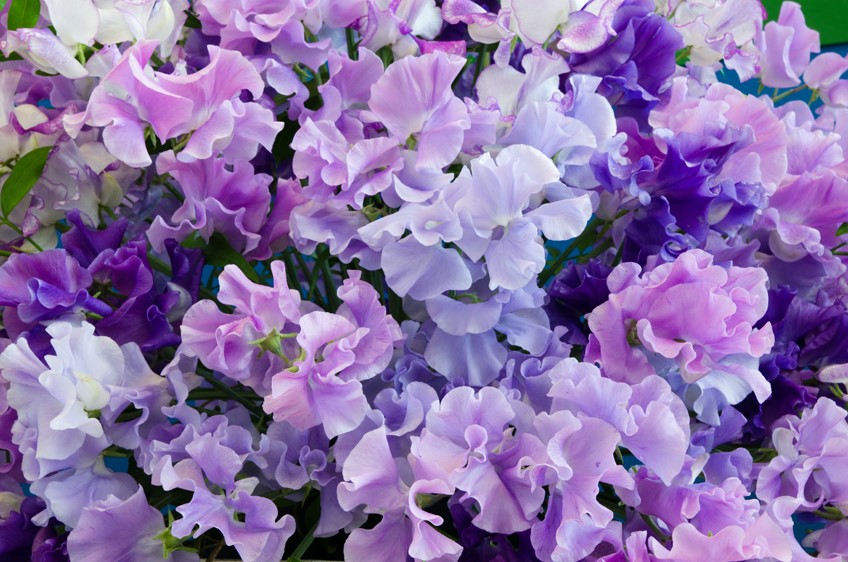When rain begins to hit the soil it will still retain autumn’s warmth. This is generally a great time for planting. Flowering annuals have the ability to establish their roots to be prepared for winter and spring flowering.
The autumn planting season extends into June for warmer climates. Here, some flowers can be planted through the year in a frost-free climate. In colder climates it is best to sow seeds earlier, think February or March. When climates are very cold you want to delay planting frost tender varieties until at least spring, once the frost has passed.
Many gardeners tend to bypass the seed sowing period and purchase ready-to-plant seedlings. ‘Potted colour’ is a name given to advanced seedlings that are flowering with their roots developed in their own pot. These plants are more expensive but are less likely to succumb to transplanting shock.
Hanging Baskets and Fill Pots
Pansies: Pansies love flowering, especially in autumn. They will continue to flower through winter, spring and into summer. They come in a huge variety of colours, even black, and they are a favourite for pot plants, hanging baskets, garden boxes and window boxes. They perform best in potting mix with fertiliser or well-drained soil. They need protection from snails. If autumn planted pansies struggle in winter, trim them back and feed them with liquid fertiliser. You will soon see a fresh crop of flowers. Traditionally, pansies aren’t great in hot weather, but many modern varieties are heat resistant.
Polyanthus: Polyanthus is a beautiful, colourful flower that offers a great variety of colours and forms. They are great for winter pots. Snip the spent flowers and feed every few weeks and they’ll produce a lovely, continuous bloom.
Lobelia: Lobelias create teaming masses of small pink, blue, purple, white or red flowers on plants which vary from mounding to upright and cascading. Cascading plants are perfect for hanging baskets whilst those mounding plants create colourful edging. One of the best blue flowers.
Alyssum: Dainty alyssum can flower year-round in a mild climate and it self sows to replenish its fragrant clumps. It is perfect for growing around paving. Alyssum requires full sun or at least part shade. They survive periods of poor soil and drought but don’t love wet conditions. Flowers are apricot, cream, pink white, purple and red. Alyssum is the perfect companion flower for bulbs, veggies and herbs. They are a great border and also an ideal mixer for hanging baskets.
Spring Flowering Bulbs
Fairy Primrose: These are ideal for planting with bulbs and for mass planting in patches of colour around shrubs or trees. They bloom in winter and spring. Tiered in shades of white, pin and purple sit atop rosettes of soft green leaves. Pretty in pots, too.
Forget-me-not: Whilst many consider this a weed, forget-me-nots actually make a successful self-seeder. Once you have them in your garden you might not need to replant to enjoy their lovely blue haze throughout spring. Once they have flowered, the spent plants are easy to remove. They are perfect as shade fillers as companion for spring flowering bulbs and also under trees. There are pink and white varieties as well as the classic blue. Sow directly into plant seedlings or the ground.
Viola: These baby pansies make up for their lack in size through great volume, smothering the plants in early spring. Being low growing and having a tidy compact habit they are perfect in the garden or as a border. They are great for planting alongside bulbs. Violas are easy to grow in semi-shade or sun, from autumn to summer. They optimise in well-drained, compost-dense soil with occasional liquid feeding.
Perfect for Picking
Iceland Poppy: Beautiful for picking, Iceland poppies contain delicate, cup-shaped flowers and come in a wide variety of lovely colours. Their flower buds and slender stems are covered in silky hairs which along the flowers will glisten in the fresh winter sun. They can grow in any climate but perform best in cool climates. In extra cold climates you want to plant in spring for summer flowering. To elongate flowering, take out spent blooms or pick for indoors. Pick flowers in the early morning and place in boiling water for 30 seconds.
 Sweet Peas: Sweet peas are adored for their fragrance and are ideal for picking. They are sown in autumn and ready to flower in spring, or the same with spring into summer. They require a climbing place, such as a bamboo tepee. They are best sown directly into well-prepared ground. They require a well-drained compost rich soil. They should be fed generously when they begin to grow liquid fertiliser. Mulch helps keep the roots cool. They begin flowering 12 – 15 weeks after sowing.
Sweet Peas: Sweet peas are adored for their fragrance and are ideal for picking. They are sown in autumn and ready to flower in spring, or the same with spring into summer. They require a climbing place, such as a bamboo tepee. They are best sown directly into well-prepared ground. They require a well-drained compost rich soil. They should be fed generously when they begin to grow liquid fertiliser. Mulch helps keep the roots cool. They begin flowering 12 – 15 weeks after sowing.



